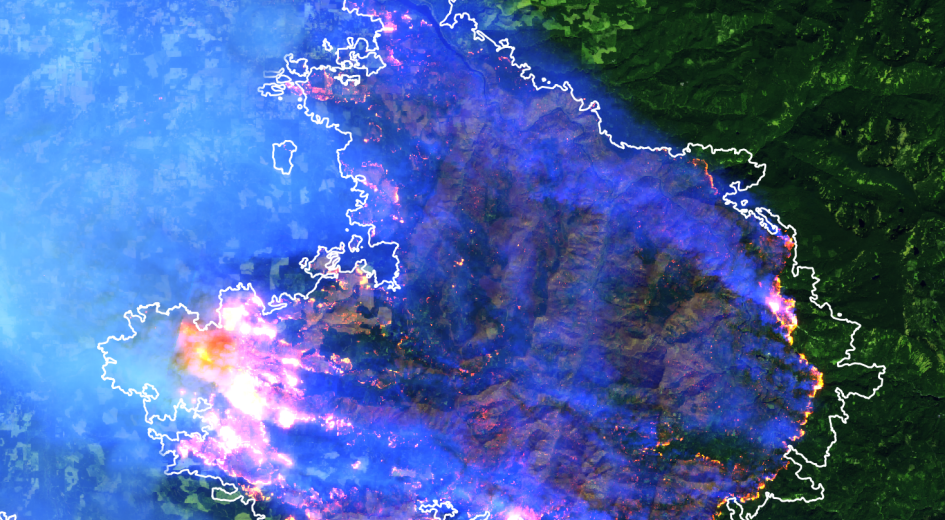At the beginning of September 2020, high heat, severe winds and extended drought conditions resulted in the volatile growth of wildfires ahead of the western slopes of the Cascades Mountains in the Pacific Northwest. The fires engulfed huge tracts of destroyed communities and forestland, taking many lives, and costing hundreds of millions to fight.
 False-color satellite imagery of the Riverside fire (with fire perimeter added) in Oregon's Western Cascades. Image courtesy of Cody Evers.
False-color satellite imagery of the Riverside fire (with fire perimeter added) in Oregon's Western Cascades. Image courtesy of Cody Evers.
In a first-ever study analyzing burn patterns from the 2020 Labor Day fires, scientists at Portland State University learned the impact of topography, weather, vegetation and other factors on burn severity in regions where over 75% of the trees were killed by the fires.
Their study verifies that extreme winds over the Labor Day holiday were the main driver of the harmful force of the fires, but also illustrates how forest vegetation structure (for example, the age of trees, canopy height, etc.) and topography played a considerable role in burn severity patterns.
The study was reported in the Fire journal.
Andrés Holz, the study’s co-author and associate professor of geography at Portland State, feels that the wet temperate forests of the Cascade Mountains in the Pacific Northwest consist of a history of undergoing mega-fires of the scale of those that were burned in 2020, but no such events had happened from the early 20th century.
As the scope and scale of the burns from 2020 were unparalleled, they offered the research team a chance to gain a better insight into the factors that tend to impact the high severity of burns caused in such rainforests. This includes those present on the western slopes of the Cascades.
That knowledge could inform scheduling for future land-use management in forestlands and the social and ecological efforts of extreme fire events in connection with a warming planet.
Maps were developed by the research team for the extent and burn severity for almost five megafires and analyzed fire activity over two time periods: September 7th and 9th, 2020. This was the time when extreme winds fueled the volatile growth of the fires, and September 10th and 17th, 2020, during which the fires remained burning under calm wind conditions.
Furthermore, the researchers analyzed how the forest structure and topography were responsible for impacting high-burn severity patterns if winds impacted the relationship between those factors, and how high burn severity was impacted by land management practices linked to land ownership.
90% of the burning occurred during high winds. But we also found that vegetation structure and canopy height were significant in determining where the fire burned more severely.
Dr. Cody Every, Study Lead Author and Research Associate, Department of Environmental Science and Management, Portland State University
The researchers discovered that regions with younger trees and low canopy height were especially vulnerable to high mortality rates. As Holz noted, this finding specifically impacts clump production in the state. Here, trees grown on plantations are normally younger and evenly spaced and situated next to communities and crucial infrastructure.
Based on the historical record, the research group, including Dr. Sebastian Busby and Associate Professor Max Nielsen-Pincus from scientists from Portland State, also indicates that wildfire managers must predict re-burns in a few regions impacted by the 2020 mega-fires.
In recent times, burned forests are generally more flammable than unburned regions till the younger forest canopy closes one more time and finer fuels are shaded.
Provided the composition of the temperate rainforests of the western slopes of the Cascade Mountains, where the fuel tends to increase, and the relationships between factors that add up to mega-fires, the research group indicates that treatments like prescribed fires and fuel reduction are not a practical method to avoid future conflagrations.
Rather, the team claims that one must concentrate on boosting strong forests, increasing community readiness, hardening infrastructure and early suppression response.
Journal Reference:
Evers, C., et al. (2022) Extreme Winds Alter Influence of Fuels and Topography on Megafire Burn Severity in Seasonal Temperate Rainforests under Record Fuel Aridity. Fire. doi.org/10.3390/fire5020041.